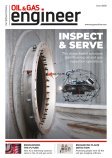The offshore energy industry is undergoing a fundamental shift in how it approaches engineering, risk and operational efficiency. Reflecting this transformation is Acteon, which has consolidated multiple specialist subsidiaries into four integrated divisions
This restructuring positions the organisation to tackle the increasingly complex challenges of offshore oil and gas and renewable energy projects.
FOUR DIVISIONS, ONE VISION
The new structure brings together four complementary business lines. Intermoor specialises in mooring and anchoring solutions, providing permanent and rental mooring systems for floating platforms such FPSOs. Menck, the marine foundations division, delivers large-scale hammering and drilling capabilities for offshore installations, including a recently commissioned 10-metre diameter drill. UTEC focuses on site surveys and geotechnical investigations, delivering the critical soil and seabed data needed for engineering and installation. Finally, Acteon’s engineering consultancy arm 2H – branded separately to maintain independence when working directly for operators – brings together 270 specialists from geotechnical engineers to naval architects to manage everything from soil analysis to integrity management.
Together, these divisions cover the full lifecycle of offshore infrastructure. “We deal with anything from the seabed all the way to the surface – anything that goes into the water,” says Yann Helle, EVP Engineering at Acteon. “That’s our purpose.”
SUBSURFACE RISK: THE HIDDEN CHALLENGE
The largest risks to offshore energy projects aren’t always visible above the waves. According to Helle, seabed and soil conditions represent the single biggest uncertainty in installation and performance. Insufficient geotechnical data can lead to costly and dangerous outcomes, such as piles unexpectedly sinking during installation or encountering uncharted boulders that halt progress.
This risk is particularly acute in the renewable sector, where wind farms require dozens or even hundreds of installations. While oil and gas wells are typically preceded by extensive coring and soil sampling, the economics of renewables make that level of investigation unfeasible. Instead of 80 soil samples for 80 turbines, developers may take only six or seven, leaving large gaps in understanding.
The result can be costly delays and unpredictable installation outcomes. “Even just two meters to the side, you might hit completely different conditions,” Helle explains. “And when you’re dealing with an area the size of ten football fields, it’s much more difficult.”
RETHINKING DATA AND SPECIFICATION
To mitigate this, Acteon’s Engineering Business Line is investing heavily in soil investigation capacity and geospatial intelligence. But Helle argues that the industry also needs to rethink how it specifies and uses data: “There’s a tendency to over-specify data requirements which drives up costs,” he says. “When you really talk to engineers, you often find you can achieve the same outcomes with a more fit-for-purpose approach.”
As such, early collaboration between operators and contractors is essential. By aligning on data needs at the outset, companies can reduce costs and accelerate timelines without compromising quality or safety. This also opens opportunities for new technologies – such as autonomous underwater vehicles (AUVs) and remote sensing – to be deployed more effectively and economically.
CLOSING THE CAPEX-OPEX GAP
Another major theme is the need for better data continuity across the asset lifecycle. Currently information captured during site investigations and installation often gets “lost in translation” between capital expenditure (CapEx) project teams and operational expenditure (OpEx) teams. “We regularly have operators come back to us asking for the design information we already handed over, because they can’t find it internally,” Helle notes.
Digitising and centralising data from day one can transform this handover, providing operators with a benchmark of asset condition and enabling predictive maintenance, optimised inspections and extended asset life. “Our role is increasingly to help clients unlock the value of the data they already have by making it accessible and usable across their organisation,” says Helle.
MINIMUM FACILITY PLATFORMS
An exciting development in offshore design is the rise of minimum facility platforms – lightweight, integrated structures that can be installed quickly and cost-effectively. Originally developed as driller-led solutions, these platforms now incorporate processing systems and other functions while weighing less than 500 tonnes. Minimum facility platforms can save anywhere between $5-10 million per installation and reduce carbon emissions associated with large construction ships. From final investment decision to first oil, Acteon’s platforms can be deployed in as little as 14 months – a crucial advantage when oil prices are low or operators face financial constraints.
“These platforms meet the same legislation as large platforms and can withstand vessel impacts,” says Helle. “Major operators are now seriously considering them, as we can get oil flowing extremely quickly. For an operator, being able to make up their investment in less than two years is a massive advantage.”
THE ROAD AHEAD
Looking forward, Acteon’s Engineering Business Line expects growth from two main streams: small, shallow-water oil projects taken on by new operators, and large renewable projects already sanctioned through 2028. The company is also piloting remote operations rather than spending weeks at sea – a move that could alleviate skill shortages, improve safety, and enhance work-life balance for offshore staff.
Ultimately, Helle sees collaboration and early engagement as the keys to unlocking the next wave of innovation. “Across the board, operators have an opportunity to work more closely with companies like ours to identify the best value, not just the lowest price,” he says. “If we can get that right – data, design, installation – we can deliver projects faster, cheaper and with a lower carbon footprint. That’s the future of offshore engineering.”
Image top page 13 - PROD2 being deployed from Ocean Zephyr on the Baltyk project



















